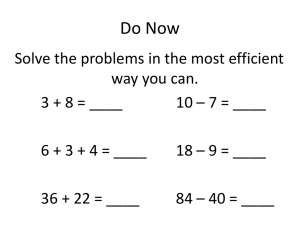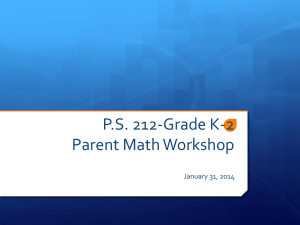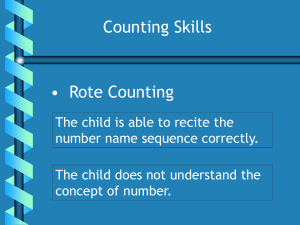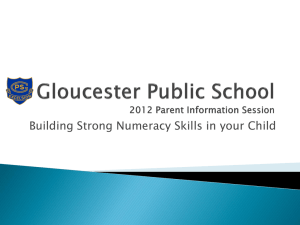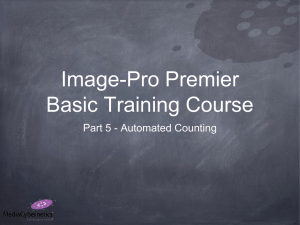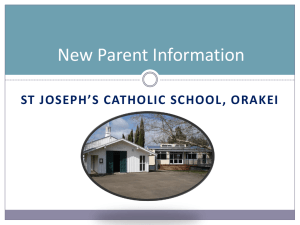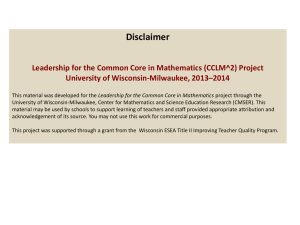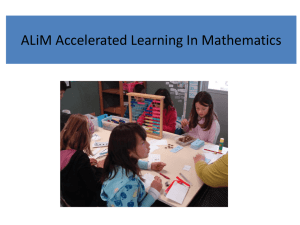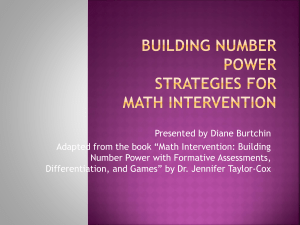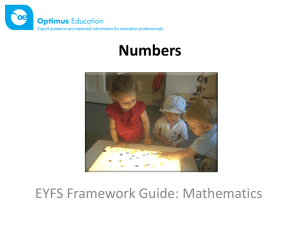The Math Team “EBook” The Addition and Subtraction Section
advertisement
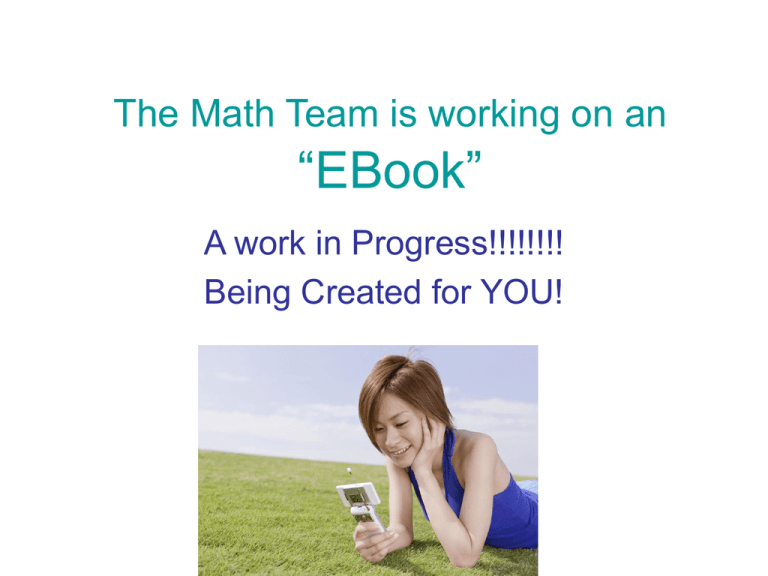
The Math Team is working on an “EBook” A work in Progress!!!!!!!! Being Created for YOU! This resource is being developed by math topic and grade level span. Each topic will include: At your request we are sharing: • Addition • Subtraction One of the richest ways to assess early counting is with sorting sets. Invite the child to sort a set of (25 to 30) objects that can be sorted in more than one way, like color and shape. After the materials have been sorted, ask some counting and amount comparison questions. • How did you decide which ones belong together? • Which group has the fewest (the least)? – How many? (How is the child counting and keeping track?) • Which group has the most? – How many? (How is the child counting and keeping track?) • Do any groups have the same amount? • Can you put these things into groups in another way? Materials: 20 to 30 small objects - shells, bottle tops, buttons, barrettes, keys etc. ---------------------------------------------------------------------------------Ask the student if some of the objects are alike in some way. Discuss likenesses and differences. Have the student put the objects into groups based upon some likeness. Ask the child to identify the groups. Have the child count the objects in each group and compare the amounts. Which group has the least? The most? Do any have the same number? Can the objects be grouped in a different way? Materials: • Pasta - penne and/or rigatoni (hollow pasta) • Yarn (with tape wrapped tightly around one end to create a needle effect) • Tie one piece of pasta to the end of the necklace so that the rest of the pieces stay on. ________________________________________________________ Explain to the student that this necklace is a counting necklace and each piece of pasta needs to be counted once and only once as it’s placed on the necklace. Ask how many pieces of pasta the necklace should include. Offer the possibility of a pattern 2 penne, 2 rigatoni etc. to create a total of (10). Discuss the importance of saying a counting word only when a piece of pasta is added to the necklace. Materials: • A calculator • Counting objects such as cubes or pennies Explain to the student that they will press a number on the calculator and then count out that number of cubes, pennies, or whatever counting object is being used. You may wish to continue the conversation by asking the child to show a group with fewer objects and a group with more objects than the number on display. Discuss the amount comparisons. • Offer fewer objects to be sorted. • Provide frequent opportunities for sorting and counting real objects. • Ask the child to move each item as it is counted. • Emphasize the language of amount comparisons – More, same number, less or fewer • Make the grouping distinctions clear – Example: different colors and sizes of plastic teddy bears When young children are confronted with addition situations or are solving addition problems, they naturally begin by counting all of the objects in the problem. Children directly model the problem with objects or with their fingers and count to combine the quantities in the problem. This counting behavior is referred to as “counting all”. Denise had 4 cookies. Her grandmother gave her 3 more. How many cookies does Denise have now? * Numbers of items are adjusted as needed. After a period of time, which differs for individual children, it’s typical that “counting all” is replaced with more efficient strategies. Usually the first strategy to follow counting all is “counting on”. Counting on generally begins from the first number given in the problem. Gradually students realize, or are led to the conclusion, that it is more efficient to count on from the larger number. Counting on is useful with small numbers like 1, 2 and 3. • Alvin had four crayons and Lashana gave him two more. How many crayons does Alvin have now? • 4 +1 is 5 5 +1 is 6 Beginning subtraction develops along with - rather than after - addition. Like addition, students begin to understand subtraction by directly modeling situations that describe the action taking something away from a group. Using objects as concrete evidence of the action helps the child keep track of the action and also helps the adult to see what the child is thinking. Unlike addition, more sophisticated strategies relating to subtraction take longer to develop. For example counting back is more challenging than counting on. It is important that initial subtraction work begin right away and be connected with addition. Addition involves putting parts of a group together into a whole, early subtraction involves removing or separating parts of the whole. This is an important relationship for students to understand. Mark had 10 presents. He gave 2 presents to children at a homeless shelter. How many presents does Mark have left? * Numbers can be changed as appropriate. Use real objects. It is important for students to use the strategies that they have acquired to begin to calculate mentally, as we often do in real life situations. Present a short problem to the children and ask them to solve it by visualizing and thinking about it in their heads. • • • • • Counting On from first and then larger number Plus one, minus one Plus two, minus two Use a known fact: 3+3=6 Doubles & Inverse of Double 4+4=8 so 8-4=4 • Counting Back • Make a Ten • Using known facts to help determine unknown facts i.e.: I know; 3+3=6 so 3+4=7 and 7-4=3 • Observe the student as he/she is solving problems. Which strategies are already being used? Does the student understand the operation? Are they able to keep track of the numbers? • Ask the student how they solve problems. This often provides insight into their thinking. • Together, determine which facts are already known (which ones are “the easy ones”) and discuss why those are easy. • Set goals for the next learning target that acknowledge strategies that are comfortable to the student. Discuss the next logical strategy that the student would like to practice to increase efficiency. Add that strategy to the learning target. • Use games and contextual problems (it helps to include the student’s name in the problems). Provide lots of practice in the target range and use the numbers that are already comfortable, as well as a low percentage of challenge numbers. Young students have to grasp the understanding that our numbers are arranged in groups of tens (or hundreds, or thousands) to help us count large quantities. We can either count all or we can count the collections of groups of tens, hundreds, thousands etc. Ten is simultaneously 10 ones and 1 group of ten. This is a complex idea for young learners. Children need to encounter principles of the base-ten number system to understand the significance of grouping by tens. This is the heart of place value. Ten frames help students to systematically develop sums to ten and to think about groups of ten. The arrangements help develop habits of noticing 5s and tens as children count in more than one way. Elise has 4 cards of stickers. There are 10 stickers on each card. She also has 6 more stickers. How many stickers does she have in all? Use a 1-100 wall chart and remove some numbers. Ask students to replace the number where it belongs in the chart. Discuss the patterns as the numbers are replaced. For example how did a student know that 16 wasn’t 61? What is the difference between these numbers? 1 2 3 4 5 11 12 13 14 15 21 22 24 25 33 34 31 6 7 8 9 10 17 18 19 20 26 27 28 29 30 35 36 37 38 40 41 42 43 44 45 46 47 48 49 50 51 52 53 54 55 56 57 58 59 60 62 63 64 65 69 70 71 72 73 74 75 76 77 78 79 80 81 82 83 84 85 86 87 88 89 90 91 92 94 95 96 97 98 99 Think of a number and describe it by * decomposing the number in some way. Give a clue and allow students to use number charts or other materials to help them solve the riddle. * Decomposing a number refers to taking a number apart into smaller numbers. – – – – I have 14 ones and 3 tens, what am I? I have 22 tens and 15 ones, what am I? I have 1 ten and 7 ones, what am I? I have 900 tens and 90 ones, what am I? Place 36 objects on the table and ask the student to estimate how many there are. (Was the estimate reasonable?) Ask about how many groups of ten could be made with the objects? (Did the student understand the question?) Have the student put the objects into groups of ten and ask if the student has an idea of how many there are altogether. If the child says no, ask how they could find out. (Did the child need to start over and count the objects one by one? Or did she count by tens and then count on the extra six?) After the child has determined that there are 36 objects, ask the student to write the number 36. Underline the 3 in 36 and ask what that digit or number in 36 means when you look at the objects. Does the student tell you that this stands for 30 or 3 groups of ten? If not ask if she can show you where that amount is in the objects. Underline the 6 in the 36 and ask what digit or number this stands for in the number 36. Can the student explain that it is 6 ones or show you with the materials? Use small erasers or lima beans and ask the student to take a handful that is as near to ten (or twenty) as possible. Have the child count the objects in an efficient way. Students may decide to count by twos or by fives. Have the student determine how far they were from the target number. How many more will be needed or how many extras were there? • Provide context for larger numbers. • Have students use individual number charts to clearly keep track of what is happening with the numbers as quantities increase and decrease. • Avoid rote procedures for trading (even with manipulatives). • Have students create groups of ten to represent quantities. • Include estimation in problem solving with larger numbers. Dear Central Region Friends, You are you are the first to see this initial work. Please help us continue to think about our product. What would you call our efforts (careful now)… I mean name this product? • Ebook?! click here to go to site We Need Your Feedback What are your reactions? Process Think Ink Pair Share
